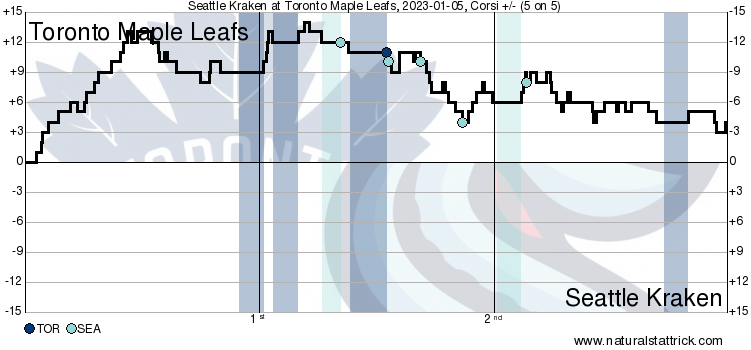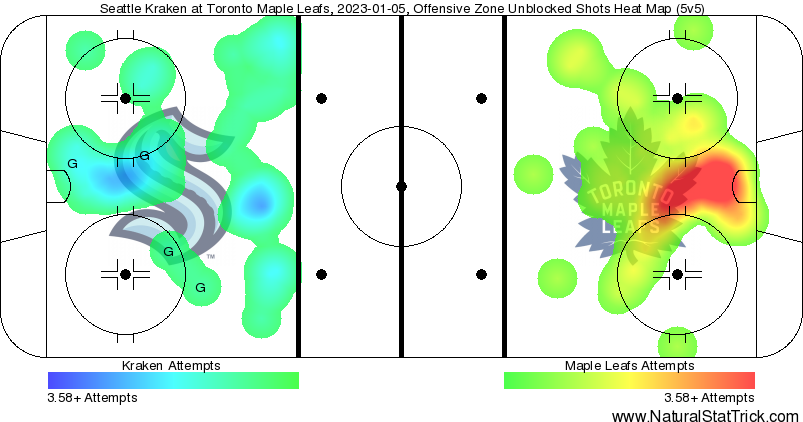In one of the more boring games of the 2022-23 Maple Leafs season, a lacklustre performance from Matt Murray and the power play sunk Toronto in a 5-1 loss to the Seattle Kraken on Thursday night.
Your game in 10:
1. The first period was a stellar period of play for the Leafs in every aspect except for actually scoring a goal. They owned puck possession, expected goals, and scoring chances thanks to a dominant first 10 minutes, in particular. The shot attempts were 15-1 in favour of the Maple Leafs by the halfway point as they asserted themselves early on with several great chances.
One Leaf who caught my eye early on was Pierre Engvall, who used his speed to create a couple of looks. The first came as he burned down the wing and tried to gain positioning on a Kraken defenseman before firing the puck into the body of Martin Jones. The second came on a 2v1 rush with Pontus Holmberg, one of many odd-man rushes the Leafs did not take advantage of early.
2. Indeed, the Leafs‘ inability to convert on their odd-man opportunities speaks to a point of frustration in this game: the pass-shot selection on the 2v1 looks. This was the case with the Engvall and Holmberg rush, and it popped up again when John Tavares tried to find Calle Järnkrok:
Tavares sauced the puck over one stick but couldn't beat the other pic.twitter.com/Jd4taFauIQ
— Omar (@TicTacTOmar) January 6, 2023
This one was broken up by a beautiful backcheck from Alex Wennberg, who laid out with his stick to disrupt the pass, and a similar story transpired with the Engvall rush. The Leafs generated a number of rush chances in the first period (more on that in a second), but they were unable to really test Martin Jones, who is the type of goalie they should really have been testing more, especially for a dangerous shooter such as Tavares.
3. In my first extended viewing of the Kraken this season, I was struck by their style of play, especially compared to last year.
Seattle was an offensive graveyard in year one as they attempted to play low-event games while getting torpedoed by bad goaltending. This year, they’re still getting bad goaltending, but they are suddenly a playoff contender due to a much better offensive game. Part of it comes thanks to the personnel additions up front — signing Andre Burakovsky from Colorado, trading for Oliver Bjorkstrand, and promoting Matty Beniers full-time — but just from watching this game, it’s clear that stylistic changes are playing a role, too.
In particular, the Kraken were playing a much more aggressive offensive-zone forecheck than I recall them playing last year. They were sending two forwards deep into the offensive zone below the goal line in some cases, pressuring Toronto defensemen and forcing the Leafs to execute quickly on breakouts. The Kraken have more than enough pace over their four lines to cause problems this way.
It didn’t force as many turnovers as intended, but I can see why it is leading to a much more offensively potent Kraken squad at five-on-five. The downside is the vulnerability it creates if the fast and aggressive forecheck is solved for, and the Leafs executed pretty efficiently to beat their forecheck and generate odd-man rushes the other way early on, particularly the 3v2s and 2v1s mentioned in the previous note.
It was a definite missed opportunity that Toronto couldn’t cash in on any of those.
4. After the first period ended without a goal, the Kraken got an opportunity early in the second period when Morgan Rielly was tabbed for a weak cross-checking call. The Seattle power play didn’t have a ton going on until the second half of the man advantage when they teed up Eeli Tolvanen for a blast from the circle:
Eeli Tolvanen scores
The shot goes off Giordano's leg pic.twitter.com/OeHcnWefvU
— Omar (@TicTacTOmar) January 6, 2023
It’s not the greatest goal Matt Murray has allowed, but there was unquestionably a change of direction due to the deflection off of Mark Giordano. After the missed opportunities earlier in the night, the Leafs were now chasing the game similar to Tuesday night vs. St. Louis.
5. With the Maple Leafs in search of an answer offensively while down 1-0, a golden opportunity arrived midway through the second period in the form of a four-minute power-play opportunity after Rasmus Sandin was clipped up high by Yanni Gourde (the penalty was awarded after a review by the officials).
The Leafs did very little for the first three minutes (we’ll get to those struggles later), but they finally capitalized in the final minute. Mitch Marner feathered a touch-pass as Mitch Marner does, and John Tavares redirected it through a double screen that included Michael Bunting and past Martin Jones:
JOHN TAVARES 🚨
RE-DIRECTION FOR THE CAPTAIN pic.twitter.com/K4gqcRdOrI
— Omar (@TicTacTOmar) January 6, 2023
I’m not sure what else needs to be said other than this was a vintage play for these two players — a perfect touch pass by Marner, and a perfect redirect by the captain. For a moment, the Leafs had the momentum.
6. That’s when the turning point of the game arrived. With the puck in the Leafs’ end following the center-ice faceoff, Justin Holl had an opportunity to execute a routine D-to-D pass to Mark Giordano behind the goal line, but he turned the puck up the wall into a couple of Seattle forecheckers. A few seconds later, a very saveable shot from the point was in the back of the net.
Vince Dunn scores immediately after pic.twitter.com/T1wqmgLkY2
— Omar (@TicTacTOmar) January 6, 2023
This was one of those momentum-swinging goals that decides a game. The Leafs drew even but were tied for barely a blink of an eye. All the energy vacated Scotiabank Arena, which returned to a morgue-like state (especially in comparison to the lively atmosphere of the WJC).
It’s hard not to wonder how differently this game plays out if Murray comes up with this save.
7. Per Justin Bourne’s pro-Holl article from this week, this was just the second game since the start of December in which Justin Holl was outscored at five-on-five (0-2 tonight). The process wasn’t great, but ultimately, the play prior to the 2-1 goal is not one we’re talking about if Matt Murray comes up with a routine stop.
It was an even rarer sight to see David Kämpf misread a play away from the puck leading to the 3-1 Kraken goal that followed soon after their 2-1 goal, creating a huge momentum swing in Seattle’s favour. Kampf was covering for an in-deep Mark Giordano and prematurely left his post to traverse the width of the ice and pursue a puck that Jaden Schwartz then stretched across the rink to (Leafs legend) Jared McCann, who buried confidently on the breakaway.
The goaltending is going to receive almost all of the attention this week (mostly understandably), but during this recent uptick in goals against, the Leafs’ forwards have not been as sharp with their details when it comes to playing connected with the defense within the five-man concept.
8. If the first couple of goals against weren’t great for Matt Murray, it didn’t get any better with the fourth. The Kraken’s top six was starting to heat up, and after a good shift, Matty Beniers pounced on a loose puck, pivoted, and fired the shot by Murray clean:
Beniers makes it 4-1 pic.twitter.com/wxDe4bNA5L
— Omar (@TicTacTOmar) January 6, 2023
That one simply can’t go in. At the tail-end of the second period, it was a backbreaker.
Murray’s last eight starts paint the picture of a goaltender blowing seriously hot and cold, seemingly following a great start-bad start pattern of late: Seattle (.808), Colorado (.929), Arizona (.810), Tampa (.947), New York (.895), Calgary (.846), Dallas (1.000).
He is apparently either “can win you a Cup” good or <.900 bad during this recent stretch. You’d certainly like a little more evenness to the performances; i.e. for the lows to be a little less low.
9. The third period was one of the sleepiest periods of hockey I’ve watched in some time. The Leafs, facing a three-goal deficit, quickly fell behind by four after Seattle finished off a rush chance.
I don’t think it was a terrible goal on Matt Murray — completed back-post passes off the rush aren’t typically “on” the goaltender — but goalies are allowed to make a big save in a tough circumstance to keep their team in the game, and it wasn’t an emphatic finish by Wennberg by any means.
I was a bit surprised that Sheldon Keefe didn’t pull Murray at this point in the game or even earlier. Maybe it speaks to the recent struggles of Ilya Samsonov, but Keefe has been similarly hesitant to yank Samsonov and throw Murray in cold. Based on his post-game answers in the past two games, it reads as though Keefe is making an intentional effort not to show any signs of panic in regard to his netminding.
Goaltending aside, it was a bit dispiriting to see the Leafs fail to mount any sort of push in the third period. This was a rare occasion this season when the Leafs were truly and obviously out of a game with almost a full period left to play.
10. The final discussion point from this game: The Maple Leafs power play’s poor showing despite scoring the team’s only goal.
The Leafs received plenty of man-advantage opportunities in this game, with five minor penalties called on the Kraken (two on the double-minor high sticking) for 9:03 in total PP time. They created just 0.48 xGF, according to Natural Stat Trick’s count. If we do the math, their xGF/60 on the PP was only marginally higher than their 5v5 figure in this game, which is obviously not what you want.
I will give Seattle some credit; they came in with a PK near the bottom of the league statistically, but they seemed hungry to turn things around. They put a lot of pressure on the puck carrier, battled hard for loose pucks, and made sure of their clearances.
For their part, the Leafs got into the zone with possession often enough, but they were mostly confined to the wings and the point, with little use of the bumper slot — outside of the Tavares deflection goal — and not much happening down low outside of one jam-play attempt by Bunting.
The five-forward PP was in action again for the Leafs in this game, but there were not a ton of positives to take out of it. They created just one high-danger chance in those nine power-play minutes — presumably, Tavares’ goal — with not much else to note.
The man advantage isn’t a true weakness at this stage, but it still feels like it has another level to find as it hovers around 10th in the league. Nights like this — with a lot of time spent deliberating on the perimeter — are one reason why.















![John Gruden after the Leafs prospects’ 4-1 win over Montreal: “[Vyacheslav Peksa] looked really comfortable in the net… We wouldn’t have won without him” John Gruden, head coach of the Toronto Marlies](https://mapleleafshotstove.com/wp-content/uploads/2025/09/gruden-post-game-sep-14-218x150.jpg)




















